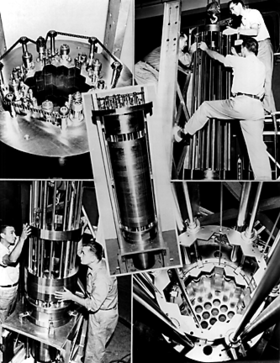
A breeder reactor is a nuclear reactor that generates more fissile material than it consumes.[1] These reactors can be fueled with more-commonly available isotopes of uranium and thorium, such as uranium-238 and thorium-232, as opposed to the rare uranium-235 which is used in conventional reactors. These materials are called fertile materials since they can be bred into fuel by these breeder reactors.
Breeder reactors achieve this because their neutron economy is high enough to create more fissile fuel than they use. These extra neutrons are absorbed by the fertile material that is loaded into the reactor along with fissile fuel. This irradiated fertile material in turn transmutes into fissile material which can undergo fission reactions.
Breeders were at first found attractive because they made more complete use of uranium fuel than light-water reactors, but interest declined after the 1960s as more uranium reserves were found[2] and new methods of uranium enrichment reduced fuel costs.
- ^ Waltar AE, Reynolds AB (1981). Fast breeder reactors. New York: Pergamon Press. ISBN 978-0-08-025983-3. Archived from the original on 5 January 2014. Retrieved 4 June 2016.
- ^ Helmreich, J. E. Gathering Rare Ores: The Diplomacy of Uranium Acquisition, 1943–1954, Princeton UP, 1986: ch. 10 ISBN 0-7837-9349-9.